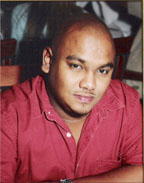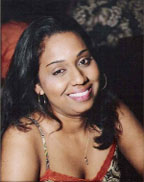You might think that the fashion clothing trade is an unlikely pursuit for a mild-mannered, ex-QC boy whose business pursuits were preceded by a full year of university studies in the discipline of Biochemistry. On the contrary, Lewis believes that his academic background, his University of Guyana degree in Business Administration and a family grounding in entrepreneurship “that goes back as far as I can remember” strategically positions him to cope with the challenges of an industry which he says “is far more complex than just buying and selling clothing.”
His perspective on the business of fashion derives from an understanding of what he says is an essential sense of self that drives most people to “look the very best that they can.” Clothing, he contends, is by far the most important physical expression of self image. “Even if you have an expensive car or an attractive house you cannot take them everywhere with you. Your clothing goes everywhere with you. How you dress makes an important statement about who you are,” he said.
A predisposition for “dressing well and looking good” Lewis says, transcends considerations of social class and financial wherewithal. “Everyone strives to look the best they can. On the streets, at work, in an interview room, everywhere, people are concerned about how they look. They understand that you never get a second chance to make a first impression.” And while he concedes that high-priced fashion clothing is beyond the reach of most people he insists that even on a relatively modest budget it is possible to look good. “It’s all about making careful choices,” he says.

John is fretful about the proliferation of cheap imitations and the popular culture of counterfeit clothing have ensnared its own considerable share of a multi-billion-dollar global clothing market, asserting that the phenomenon exploits consumer attraction to brand names while being altogether unmindful of people’s expectations of what they buy; and while he concedes that cheap imitations can engender some measure of instant gratification he insists that “quality clothing is always a good investment” and that “the cheap imitations are often one-time wears and frequently a waste of money.”
There is, John says, a passion among Guyanese “to look good.” No less than people elsewhere Guyanese are adherents of the brand-name culture that is embedded in the aggressive, big-budget global advertising regimen of metropolitan fashion houses. It is from these capitals of fashion, Lewis says that the clothing conscious in Guyana take their cue.
Among local fashion merchants the competition is fierce but varied tastes and the insatiable appetite of a continually growing market makes the industry a worthwhile one for the investor. Lewis follows fashion, through visits to clothing and apparel events mostly in North America. Other proprietors in the local fashion industry also look to international suppliers and Lewis says that, as a general rule, he would not do business with overseas suppliers who have other clients in Guyana. It is, he says, his way, of maintaining a measure of uniqueness in the apparel that his store offers.

These days, he does an increasing volume of internet shopping. Information technology, he says, has radically transformed the fashion industry and more particularly the marketing of fashion. “A lot of my assessment of the industry and my purchasing decisions are done through the internet. The popular media, particularly television, drives the fashion industry. What people wear on television – television presenters, models, celebrities – provides a constant source of ideas for fashion.”
Sometimes, however, he has to travel. Lewis believes that the selection process must sometimes be informed by establishing an intimacy with what he purchases. “A lot of this has to do with what I believe are some basic differences in the outlook of men and women as far as clothing is concerned. My experience has been that, on the whole men tend to dress for comfort. Women on the other hand are more focused on style. Here, I am not suggesting that there are not many fashion-conscious men; what I am saying is that because there are often more complex considerations in women’s choices, greater care has to be exercised in the selection of women’s apparel.”
Lewis’ sense of what is fashionable, “what looks good” derives from a combination of his personal artistic inclinations and his exposure to the patterns and practices that are part of the international fashion industry. His passion for architecture led him to design his own home while his understanding of color and its psychological effects has helped inform his clothing acquisition choices. He understands the nexus between season and color that underpins the orientation of the metropolitan fashion industry. Reds, he says, engender “an energetic, upbeat feeling” and are associated with the spring/summer season. “The Autumn/ Winter period ushers in darker colours.” Last year, in May and November, John Lewis Styles staged two fashion shows at the Pegasus Hotel. “For the May event the hotel simply wanted me to make the clothing available and have them do the rest. I declined. I did it all myself. It felt good to immerse myself in the real world of fashion. It is a world that I love.”
Lewis’s own preoccupation, he says, is with removing at least some of the aura of exclusivity that attends the fashion clothing industry. “Good clothing will always cost more but accessibility is still important.” He strives for this, he says, by a carefully thought-out buying strategy that takes him directly to authentic distributors where volumes of purchases facilitate better prices that enable more competitive retailing.
Lewis concedes that his target market is, principally, what he describes as the “middle tier,” people with a measure of disposable income. Still, he says, he aims to be competitive among similar local establishments. “Its always a good feeling when most people feel they can afford your prices particularly when you know that you are offering quality clothing. I purchase in volumes because much of my preoccupation is with what people can afford.”
Lewis believes that even in a challenging 2009 the fashion clothing industry held its own. He attributes this to the fact that hard times, perhaps, makes people work even harder to “look their best.” Besides, he says, “dressing is about looking and feeling good.”
John Lewis is looking to grow. Inside his cramped office he talks about his preoccupation with expansion, with moving to bigger premises, with offering more to the fashion industry. He is, however, acutely conscious about his limitations. “I have to grow in a manner that I can afford.”
That apart, Lewis says that he is concerned that the uniqueness of his establishment not be swallowed up in what he sees as the lesser mindfulness of the downtown trading culture. Somehow, you sense that his perspective of where he wants to take the local fashion clothing industry is informed not by conceit or arrogance but by what he believes is the importance of sustaining his own unique space in a sector that does so much to shape people’s perceptions of themselves.




